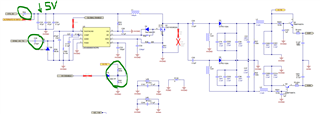Other Parts Discussed in Thread: TIDA-010057,
Hi We have manufactured the TIDA-010057 PCB and have started testing.
The only portion of the circuit we are having trouble with is the LM3488 HV Section.
We are not getting outputs on the HVP and HVM Rails in the order of milli Volts.
Also Inductor L1 is getting extremely hot.
Getting no oscillating signal out on Pin 6 (DR) Signal of the LM3488.
ANy advise where to start looking would be highly appreciated.


